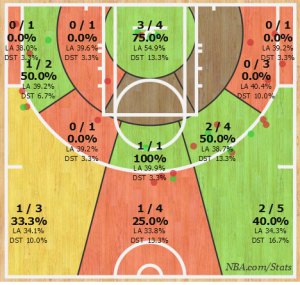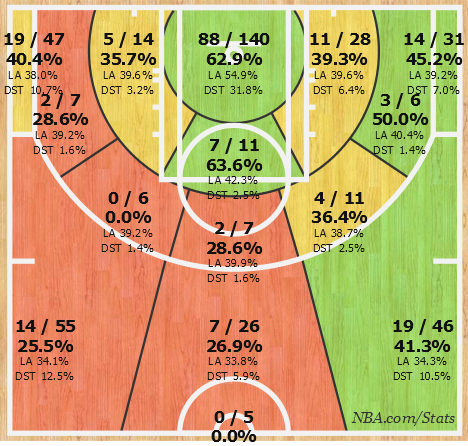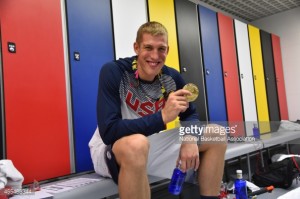The key to the Brooklyn Nets’ playoff push to end their 2014-15 season was clearly Earl Clark all along. Since signing a ten-day contract on March 27th - two days after Thaddeus Young hyper-extended his left knee against the Charlotte Hornets - the Nets won eight of their remaining 12 games and prolonged their season another couple of weeks by claiming the Eastern Conference’s final playoff spot. Clark appeared in just 93 minutes across 10 regular season games, but the Brooklyn offense jumped to the seventh-best in the league once he joined the team. Since correlation obviously indicates causation, we have no choice but to attribute the offensive boost soley to Clark’s presence.
Earl Clark’s impact was less tangible on the court, at least from his traditional statistics and on-/off-court numbers. Hampered by the limited playing time, he averaged 2.7 points and 2.3 rebounds per game on 43.8/28.6/25 triple-slash shooting percentages (on two-point field goals, threes, and free throws), which look a little better translated per 36 minutes, with 10.5 points, 8.9 boards, 1.5 blocks, and 1.2 steals per game. In his 106 minutes on the court (including the regular season and playoffs), the Nets were outscored 193-231, and the team shot 6.5 percentage points better overall with Earl Clark off the court but over six points better from three with him on the floor, per NBA Wowy.

Earl Clark’s 2014-15 shot cart, courtesy of NBA.com/stats
Clark wouldn’t exactly get his opportunity to showcase his skills in the playoffs. His most substantial showing was his 1/6 shooting performance over eight minutes in Game 1 in Atlanta, where he made a three-pointer, collected a rebound and a steal, and finished with a single-game plus-minus of -10 in a 92-99 loss. Clark would play again in the closing minutes of a deciding Game 6, bringing his postseason totals to 13 minutes, six points (on 2/10 field goals and 2/3 from three), two rebounds, and a steal.
Given Earl Clark’s pedigree and positional versatility, and the Nets’ needs in the frontcourt after the Young injury, his signing to a ten-day contract was a nice buy-low audition. Young’s knee injury resulted in a minor absence from the starting lineup, which head coach Lionel Hollins countered by promoting Mason Plumlee to the starting power forward position alongside Brook Lopez. Hollins experimented with some small-ball lineups all season but lacked a true backup power forward once Mirza Teletovic was ruled inactive in January, while Clark put up big numbers with stops in the NBA Developmental League and in China. Of Clark’s 106 minutes with Brooklyn, 94% came at (backup) power forward, by Basketball-Reference’s numbers, with the other 6% at center.
Earl Clark’s ability to play either big man position results in plenty of open jumpers and gives the offense a spacing and pick-and-pop option. Not a natural three-point shooter early in his career, Clark increased his output in his last two seasons, taking 46.7% of his nearly 300 shot attempts from beyond the arc. He connected on 33.6% of his 122 three-point shots last season with the Cleveland Cavaliers and New York Knicks and 4/14 (28.6%) with the Nets, and is much more comfortable spotting up than slashing to the basket or playing in the post (just 38 free throw attempts over the last two seasons).
It’s tough to draw too much significance into Clark’s 2014-15 stats, considering the extremely small sample size. Perhaps his upward trend in defensive rebounding rate (to 26.5% of rebounding opportunities last season) is sustainable, as he ages and adds muscle to his 6’10” frame. He’ll need to continue to work on his jumper at the NBA level after suffering a 4-point drop in true shooting percentage in each of the last three seasons, and he’ll enter his age-28 season on a partially-guaranteed contract.
According to Basketball Insider’s Eric Pincus, the second year of Earl Clark’s contract includes a guarantee of $200,000 if he remains on the roster past October 26th, and a $1.185 million salary if he lasts the season. The fact that Brooklyn Nets general manager Billy King included a non-guaranteed second year on the deal could represent an interest in developing the New Jersey native over an offseason at the cost of the NBA minimum, or he could see Clark as a potential trade attachment in a larger deal and to a team that needs to trim cap space. More likely is that Clark ends up waived or traded (and then waived) before he even sees that $200k check.
The Nets could upgrade the backup power forward position through free agency or with some in-house, younger options. Clark’s signing to his first ten day was a necessity with the Nets down to just one healthy power forward at the time (rookie Cory Jefferson), and gave Lionel Hollins a more experienced option who could help on the glass and stretch the floor a bit. The flip side is that it gave Hollins a more experienced option, who helped to steal playing time away from fan favorites Jerome “Preseason Kareem” Jordan and plus-minus prodigy Cory Jefferson.
That’s not to say that the inexperienced Jefferson could have raised the Nets’ playoff ceiling, either, but his particular brand of bouncy, kinetic energy and desire to dunk all over his opponents were qualities that Earl Clark couldn’t replicate. Though he’s a solid mid-range shooter thus far into his career (51.9% from 10-16 feet), Jefferson is unable to open up the court all the way to the three-point line like Clark can (2/15 from three in his rookie season) and would have probably driven his head coach crazy with his defensive lapses over extended minutes.
Once Clark joined the team on March 27th, Cory Jefferson played 8.1 minutes per game in six games down the stretch, which was down about three minutes a game from before the signing. He’ll have every opportunity to prove himself in training camp as he works to gain Lionel Hollins’s trust and minutes in the big man rotation, and to possibly make Earl Clark expendable.
Whether it’s with the Brooklyn Nets in 2015-16 or for another NBA organization, Clark will have to continue fighting for opportunities, minutes, and another guaranteed contract. His catch-and-shoot skills could make him an effective role player in today’s NBA, given a more consistent three-point stroke, and particularly if his rebounding continues to improve. It’ll be a summer (and training camp) spent sweating out his contract status with the Brooklyn Nets, but Earl Clark has been no stranger to the transitory nature of professional basketball in playing for six NBA teams in six seasons, and should have no problem fielding job offers both domestic and internationally, if not with the Nets, next season.



